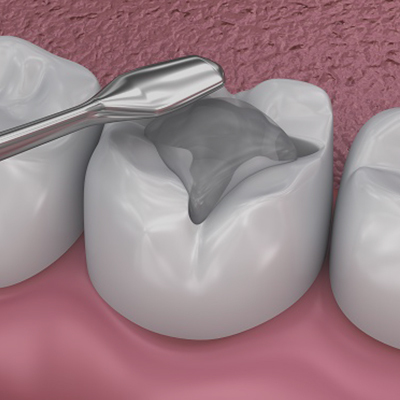
When it comes to restoring teeth affected by decay, dentists have a variety of materials at their disposal. Two of the most commonly used are amalgam fillings and resin-based composite fillings. Understanding the differences between these materials can help patients make informed decisions about their dental care.
Composition and Appearance
Amalgam fillings, often referred to as “silver fillings,” are composed of a mixture of metals, including mercury, silver, tin, and copper. This combination results in a durable material with a metallic appearance, making amalgam fillings easily distinguishable from natural tooth structure. On the other hand, resin-based composite fillings are made from a blend of plastic resins and fine glass particles. These composites can be color-matched to the patient’s natural tooth shade, providing a more aesthetically pleasing result.
Durability and Longevity
Durability is a crucial factor when considering filling materials. According to the American Dental Association (ADA), “amalgam fillings have been the gold standard for direct materials in terms of durability and longevity.” Studies have shown that amalgam restorations often have a higher survivability rate compared to resin composites, especially in large restorations and those with heavy chewing forces.
However, advancements in dental materials have significantly improved the performance of resin-based composites. According to a 2020 systematic review published in the Journal of the American Dental Association (JADA), composite restorations can perform as well as, if not better than, amalgam in certain situations. The review reported an annual failure rate of 2.19% for large posterior composite restorations, which is comparable to amalgam.
Aesthetics
One of the most significant advantages of resin-based composites is their aesthetic appeal. Since they can be closely matched to the natural color of teeth, they are virtually indistinguishable once placed. This makes them particularly suitable for restorations in visible areas of the mouth. In contrast, the metallic color of amalgam fillings can be more noticeable, which may be a concern for some patients.
Placement Technique and Tooth Preservation
The procedures for placing amalgam and composite fillings differ notably. Amalgam fillings require the removal of more tooth structure to create a cavity shape that mechanically holds the filling in place. Conversely, composite fillings bond directly to the tooth, allowing dentists to preserve more of the natural tooth structure during preparation. This adhesive property of composites supports a more conservative approach to tooth restoration.
Moisture Sensitivity During Placement
The success of a filling also depends on the conditions during its placement. Amalgam is relatively tolerant to moisture, making it more forgiving in situations where achieving a completely dry field is challenging. In contrast, resin-based composites require a dry environment during placement to ensure proper adhesion and to prevent moisture contamination, which can compromise the integrity of the restoration.
Thermal Expansion
Materials expand and contract with temperature changes, and this property is measured by the coefficient of thermal expansion. Composite resins have a higher coefficient of thermal expansion compared to natural tooth structure, which can lead to stresses at the tooth-restoration interface over time. Amalgam’s thermal expansion properties are closer to that of natural teeth, potentially reducing this risk.
Potential Health and Environmental Concerns
The mercury content in amalgam fillings has been a topic of debate due to potential health risks. However, according to the ADA, “extensive research and reviews have reaffirmed that dental amalgam is a durable, safe, and effective cavity-filling option.” Nevertheless, environmental concerns about mercury have led to international agreements, such as the Minamata Convention, aiming to reduce mercury usage.
Resin-based composites eliminate mercury-related concerns but introduce other considerations. Some composites contain substances like Bisphenol A (BPA), an endocrine disruptor. While the levels of BPA in dental composites are low, ongoing research continues to evaluate any potential health implications.
Wear Resistance and Fracture Rates
Amalgam’s durability makes it particularly suitable for high-stress areas, such as the chewing surfaces of molars. Composite resins, while improved, may still exhibit higher wear rates and are more prone to fractures, especially in larger restorations. However, with advancements in composite materials and techniques, these differences are diminishing.
Cost Considerations
Cost is an important factor for many patients when choosing a filling material. Amalgam fillings are generally less expensive than resin-based composites. However, the aesthetic and tooth-preserving benefits of composites may justify the higher cost for some individuals. Insurance coverage can also influence the final out-of-pocket expense, as some policies may have different reimbursement rates for each material.
Conclusion
Both amalgam and resin-based composite fillings have their respective advantages and limitations. Amalgam offers durability, longevity, and cost-effectiveness, making it a reliable choice for many years. Resin-based composites provide superior aesthetics and allow for more conservative tooth preparation, aligning with modern dental practices that emphasize tooth preservation.
When deciding between the two, it’s essential to consider factors such as the location of the cavity, aesthetic preferences, cost, and any potential health concerns. A thorough discussion with your dentist can help determine the best option tailored to your dental needs.
For more information on dental materials and their benefits, visit the American Dental Association (ADA) website at www.ada.org.
Schedule Your Appointment with a Leading Dentist in Woodland Hills, Los Angeles
If you’re looking for a woman dentist in Woodland Hills and surrounding areas who prioritizes minimally invasive dentistry, exceptional care, and patient comfort, Dr. Argina Kudaverdian at 32ology Dental Studio is here for you.
We look forward to helping you achieve a healthier, more beautiful smile! ✨
32ology Dental Studio – General & Cosmetic Dentistry
18740 Ventura Blvd., Ste 108 Tarzana CA 91356
Tel.: (818) 776-1236
Serving : Tarzana | Sherman Oaks | Encino | Woodland Hills | West Hills | Reseda